#david la rue
Explore tagged Tumblr posts
Text
Please send in requests
I do NOT write smut
I will write certain ships x reader(Percabeth x reader, Jegulus x reader, Wolfstar x reader, Solangelo x reader, etc.) if you have any specific ones for any of the fandoms I write for please message me and ask
I write female readers, male readers, gender neutral readers(please specify when requesting)
I write (x reader) head canons, blurbs and longer fics for these fandoms:
PJO
HOO
TOA
criminal minds(seasons 1-15)
marauders
#Percy Jackson x reader#Jason Grace x reader#Annabeth Chase x reader#Leo Valdez x reader#Will Solace x reader#Nico Di Angelo x reader#Frank Zhang x reader#Clarisse La Rue x reader#Luke Castellan x reader#Hazel Levesque x reader#Piper McLean x reader#Reyna Ramirez Arellano x reader#Lester Papadopolous x reader#PJO Apollo x reader#Aaron Hotchner x reader#Spencer Reid x reader#Derek Morgan x reader#Jennifer Jareau x reader#Emily Prentiss x reader#Luke Alvez x reader#Tara Lewis x reader#David Rossi x reader#James Potter x reader#Sirius Black x reader#Remus Lupin x reader#Regulus Black x reader
42 notes
·
View notes
Text






Boti Bliss - CSI Miami; with Jonathan Togo & Adam Rodriguez

Megalyn Echikunwoke - CSI Miami


Brendan Fehr - CSI Miami, Biker Boyz





















Eva La Rue - CSI Miami, with Jonathan Togo, Adam Rodriguez, David Caruzo, Emily Procter
3 notes
·
View notes
Text
My savefile ♡ SECOND PART
FIRST PART HERE
Playable worlds
♡ Brindleton Bay ♡ Britechester ♡ Chestnut Ridge ♡ Copperdale ♡
♡ Del Sol Valley ♡ Henford-on-Bagley ♡ Magnolia Promenade ♡
♡ Mt. Komorebi ♡ Oasis Springs ♡ San Myshuno ♡
♡ San Sequoia ♡ Sulani ♡ Tartosa ♡ Windenburg ♡

Brindleton Bay Sable Square
♡ Brindleton Pawspital by @bojanastarcevic (lot size 40 x 30)
♡ Farm to Table Restaurant by @simpolcheeks filled with cc by @kekeyw (lot size 40 x 30)
♡ Lucio's Market by @rheya28 (lot size 30 x 20)
♡ Golden Spice Restaurant by @rheya28 (lot size 30 x 30)
♡ Devon's haven by @plantyl-m (lot size 40 x 30)
Whiskerman's Wharf
♡ Four Winds Community Garden by @bojanastarcevic (lot size 40 x 30)
♡ *The Ivy Townhouses by @swanettesims (lot size 40 x 30)
Cavalier Cove
♡ Everbright Home by @honeybellabuilds (lot size 30 x 20)
♡ Hound’s Head Country Club by @shaymoo22 (lot size 64 x 64)
♡ Cozy autumnal family house by @bojanastarcevic (lot size 20 x 20)
♡ Modern Farmhouse by @bojanastarcevic (lot size 40 x 40)
♡ Little Modern Farmhouse by @summerrplays (lot size 30 x 20)
Deadgrass Isle

Del Sol Valley Mirage Park
♡ Leila Square Apartment by @rheya28 (lot size 40 x 30)
♡ The Forsy Building by @softerhaze (lot size 40 x 30)
The Pinnacles
♡ The Griya Lesmana, luxury residence by @lesmana-enterprise-ltd (lot size 50 x 40)
♡ Celebrity Manor by @beulahsdaisy (lot size 64 x 64)
♡ Minimalist glass house by @bojanastarcevic (lot size 50 x 40)
Starlight Boulevard
♡ Santini`s by @shaymoo22 (lot size 40 x 30)
♡ Concert Stage by plumbobkindom (lot size 20 x 20)
♡ Del Sol Dance Studio* by @magdalune (lot size 30 x 30)
♡ El Arbol Fusion Restaurant (lot size 40 x 30)
♡ IronWorks Fitness Centre by @rheya28 (lot size 40 x 30)

Britechester University of Britechester
♡ Drake Hall by @bojanastarcevic (lot size 30 x 20)
♡ Wyvern Hall* by @simkhira (lot size 30 x 20)
♡ Britechester Townhouses* by @farfallasims (lot size 30 x 20)
♡ Kupfergraben Townhouse by @honeybellabuilds (lot size 30 x 20)
Foxbury Institute
♡ Britechester Art Gallery* by plumbobkindom (lot size 40 x 30)
♡ Garden Center by @jakkkuu (lot size 30 x 20)
♡ Briny Tower by @magic-mili (lot size 30 x 20)
♡ Tidal Tower by @dreamscarx (lot size 30 x 20)
Gibbs Hill
♡ Maison de Fleurs by @honeybellabuilds (lot size 20 x 20)
♡ The Pâtisserie on Grande Rue by @honeybellabuilds (lot size 20 x 15)
♡ Tulip Townhouse by @honeybellabuilds (lot size 20 x 15)
♡ Kensington Townhouses by @farfallasims (lot size 20 x 15)
♡ London Townhouses by @evarotky (lot size 50 x 50)

Magnolia Promenade PARIS
♡ Place De Valois by @jakkkuu (lot size 40 x 30)
♡ JO MALONE STORE & LA MARIE BEAUTY SPACE (lot size 20 x 20) by me
♡ SIMPARI Restaurant by @jakkkuu (lot size 20 x 20)
♡ Chanel Store (lot size 30 x 20) by me

Mt. Komorebi Wakaba
♡ The Jeong House by @themintsimmer (lot size 30 x 20)
♡ Oracle Cafe by @plantyl-m (lot size 30 x 20)
♡ Yugen Hair & Spa by @vylewa (lot size 20 x 15)
♡ Lakeside Mansion* by @aashwarr (lot size 50 x 50)
♡ Korean Cafe & Apartment by @paleanelo-sims (lot size 20 x 15)
Senbamachi
♡ Japandi Inspired Cafe and Restaurant by @vylewa (lot size 20 x 15)
♡ Japandi Townhouses by @farfallasims (lot size 30 x 20)
♡ Snowy Xmas Cabin by @bbygyal123 (lot size 30 x 20)
♡ David`s house* by @bojanastarcevic (lot size 20 x 15)
♡ Calm family house by yohannabuilds (lot size 30 x 20)
Yukimatsu
♡ kōrien icerink by @rivzai (lot size 30 x 20)
♡ Ten Leaves Spa & Rental by @rheya28 (lot size 50 x 50)
♡ Kurokawa Onsen by @rheya28 (lot size 30 x 20)
♡ Yoi Jikan Nightclub by @themintsimmer (lot size 30 x 20)
Map replacement by 20thcenturyplumbob
last update 15/02/2025
#sims4#simblr#simsthetic#sims 4#sims 4 save file#save file#save file sims 4#del sol valley#britechester#mt. komorebi#magnolia promenade#my save file#brindleton bay
513 notes
·
View notes
Text

Madame Récamier
Artist: Jacques-Louis David (French, 1748–1825)
Date: 1800 (Unfinished work)
Medium: Oil on canvas
Collection: Musée du Louvre, Paris, France
Description
The Portrait of Madame Récamier is a painting by Jacques-Louis David depicting Juliette Récamier seated on a sofa. The painting began in May 1800was deliberately left unfinished by David, when he learned that François Gérard had also been commissioned to do a portrait of the same model.
Painted at the age of 23, Juliette Récamier (née Jeanne Bernard) was the daughter of an advisor to Louis XV I and married the wealthy banker Jacques-Rosé Récamier in 1793 at the age of 15. Renowned for her beauty and wit, she held a salon in her private mansion located at 7 rue de la Chaussée-d'Antin , which was frequented in particular by Germaine de Staël and Benjamin Constant , until 1803 when the government closed it because it was considered a hotbed of opposition to the First Consul.
In an elongated format, the painting represents Juliette Récamier semi-reclining on a chaise longue in a sideways posture, her upper body turned towards the viewer in a twisting movement. Her gaze fixes the painter. She is dressed in a long white antique dress, the bottom of which falls draped on the ground. Her short, curly hair is tied with a wide ribbon, she is barefoot. She is resting on a sofa , her left arm resting on two cushions , the right is resting on her leg. At the foot of the sofa is a stool , to the left of the painting an antique-style candelabra like the rest of the furniture, quite spartan. The painting is not signed.
#portrait#painting#oil on canvas#french culture#french art#artwork#fine art#juliette recamier#chaise longue#full length#long white antique dress#candelabra#jacques louis david#french painter#european art#louvre museum
28 notes
·
View notes
Note
I understand the story of marat and his assassination event
But who is lepeletier?
Because I saw a drawing for him by louis David and I learned about his death which happen to be the same as Marat so yeah .. I wanna know about him.
According to the biography Michel Lepeletier de Saint-Fargeau, 1760-1793 (1913), its subject of study was born on 29 May 1760, in his family home on rue Culture-Sainte-Catherine, a building which today is the Bibliothèque Historique de la Ville de Paris. His family belonged to the distinguished part of the robe nobility. At the death of his father in 1769, Lepeletier was both Count of Saint-Fargeau, Marquis of Montjeu, Baron of Peneuze, Grand Bailiff of Gien as well as the owner of 400,000 livres de rente. For five years he worked as avocat du roi at Châtelet, before becoming councilor in Parliament in 1783, general counsel in 1784 and finally taking over the prestigious position of président à mortier at the Parlement of Paris from his father in 1785. On May 16 1789, Lepeletier was elected to represent the nobility at the Estates General. On June 25 the same year he was one of the 47 nobles to join the newly declared National Assembly, two days before the king called on the rest of the first two estates to do so as well. A month later, during the night of August 4 1789, he was in the forefront of those who proposed the suppression of feudalism, even if, for his part, this meant losing 80 000 livres de rente. Four days later he wrote a letter to the priest of Saint-Fargeau, renouncing his rights to both mills, furnaces, dovecote, exclusive hunting and fishing, insence and holy water, butchery and haulage (the last four things the Assembly hadn’t ruled on yet). When the Assembly on June 19 1790 abolished titles, orders, and other privileges of the hereditary nobility, Lepeletier made the motion that all citizens could only bear their real family name — ”The tree of aristocracy still has a branch that you forgot to cut..., I want to talk about these usurper names, this right that the nobles have arrogated to themselves exclusively to call themselves by the name of the place where they were lords. I propose that every individual must bear his last name and consequently I sign my motion: Michel Lepeletier” — and the same year he also, in the name of the Criminal Jurisprudence Committee, presented a report on the supression of the penal code and argued for the abolition of the death penalty. After the closing of the National Assembly in 1791, Lepeletier settled in Auxerre to take on the functions of president of the directory of Yonne, a position to which he had been nominated the previous year. He did however soon thereafter return to Paris, as he, following the overthrow of the monarchy, was one of few former nobles elected to the National Convention, where he was also one of even fewer former nobles to sit together with the Mountain. In December 1792 he started working on a public education plan. On January 17, Lepeletier voted for death in the ongoing trial of Louis XVI (saying only ”I vote for death” without giving any further motivation) Three days later, the former king was sentenced to said penalty. That night, Lepeletier went over to Palais-Égalité (former Palais-Royal) where he dined everyday. The next day, his friend and fellow deputy Nicolas Maure could report the following to the Convention:
Citizens, it is with the deepest affection and resentment of my heart that I announce to you the assassination of a representative of the people, of my dear colleague and friend Lepelletier, deputy of Yonne; committed by an infamous royalist, yesterday, at five o'clock, at the restaurateur Fevrier, in the Jardin de l'Égalité. This good citizen was accustomed to dining there (and often, after our work, we enjoyed a gentle and friendly conversation there) by a very unfortunate fate, I did not find myself there; for perhaps I could have saved his life, or shared his fate. Barely had he started his dinner when six individuals, coming out of a neighboring room, presented themselves to him. One of them, said to be Pâris, a former bodyguard, said to the others: There's that rascal Lepeletier. He answered him, with his usual gentleness: I am Lepeletier, but I am not a rascal. Paris replied: Scoundrel, did you not vote for the death of the king? Lepelletier replied: That is true, because my confidence commanded me to do so.Instantly, the assassin pulled a saber, called a lighter, from under his coat and plunged it furiously into his left side, his lower abdomen; it created a wound four inches deep and four fingers wide. The assassin escaped with the help of his accomplices. Lepeletier still had the gentleness to forgive him, to pray that no further action would be taken; his strength allowed him to make his declaration to the public officer, and to sign it. He was placed in the hands of the surgeons who took him to his brother, at Place Vendôme. I went there immediately, led by my tender friendship, and my reverence for the virtues which he practiced without ostentation: I found him on his death bed, unconscious. When he showed me his wound, he uttered only these two words: I'm cold. He died this morning, at half past one, saying that he was happy to shed his blood for the homeland; that he hoped that the sacrifice of his life would consolidate Liberty; that he died satisfied with having fulfilled his oaths.
This was the first time a Convention deputy had gotten murdered, and it naturally caused strong reactions. Already the same session when Maure had announced Lepeletier’s death, the Convention ordered the following:
There are grounds for indictment against Pâris, former king's guard, accused of the assassination of the person of Michel Lepelletier, one of the representatives of the French people, committed yesterday.
[The Convention] instructs the Provisional Executive Council to prosecute and punish the culprit and his accomplices by the most prompt measures, and to without delay hand over to its committee of decrees the copies of the minutes from the justice of the peace and the other acts containing information relating to this attack.
The Decrees and Legislation Committees will present, in tomorrow's session, the drafting of the indictment.
An address will be written to the French people, which will be sent to the 84 departments and the armies, by extraordinary couriers, to inform them of the crime against the Nation which has just been committed against the person of Michel Lepelletier, of the measures that the National Convention has taken for the punishment for this attack, to invite the citizens to peace and tranquility, and the constituted authorities to the most exact surveillance.
The entire National Convention will attend the funeral of Michel Lepelletier, assassinated for having voted for the death of the tyrant.
The honors of the French Pantheon are awarded to Michel Lepelletier, and his body will be placed there.
The president is responsible for writing, on behalf of the National Convention, to the department of Yonne, and to the family of Lepelletier.
The next day, January 22, further instructions were given regarding Lepeletier’s funeral:
On Thursday January 24, Year 2 of the Republic, at eight o'clock in the morning, will be celebrated, at the expense of the Nation, the funeral of Michel Lepeletier, deputy of the department of Yonne to the National Convention.
The National Convention will attend the funeral of Michel Lepeletier in its entirety. The executive council, the administrative and judicial bodies will attend it as well.
The executive council and the department of Paris will consult with the Committee of Public Instruction regarding the details of the funeral ceremony.
The last words spoken by Michel Lepeletier will be engraved on his tomb, they are as follows: “I am happy to shed my blood for the homeland; I hope that it will serve to consolidate Liberty and Equality; and to make their enemies recognized.”
In number 27 (January 27 1793) of Gazette Nationale ou Le Moniteur Universel, the following long description was given over Lepeletier’s funeral, held three days earlier:
The funeral of Lepeletier Saint-Fargeau was celebrated on Thursday 24 with all the splendor that the severity of the weather and the season allowed, but with such a crowd that it could have been the most beautiful day of the year. At ten o'clock in the morning his deathbed was placed on the pedestal where the equestrian statue of Louis XVI previously stood, on Place Vendôme, today Place des Piques. One went up to the pedestal by two staircases, on the banisters of which were antique candelabras. The body was lying on the bed with the bloody sheets and the sword with which he had been struck. He was naked to the waist, and his large and deep wound could be seen exposed. These were the mournful and most endearing part of this great spectacle. All that was missing was the author of the crime, chained, and beginning his torture by witnessing the sight of the triumph of Saint-Fargeau. As soon as the National Convention and all the bodies that were to form courage were assembled in the square, mournful music was played. It was, like almost all those which has embellished our revolutionary festivals, the composition of citizen Gossec. The Convention was ranged around the pedestal. The citizen in charge of the ceremonies presented the President of the Convention with a wreath of oak and flowers; then the president, preceded by the ushers of the Convention and the national music, went around the monument, and went up to the pedestal to place the civic crown on Lepeletier's head: during this time, a federate gave a speech; the president dismounted, the procession set out in the following order: A detachment of cavalry preceded by trumpets with fourdincs. Sappers. Cannoneers without cannons. Detachment of veiled drummers. Declaration of the rights of man carried by citizens. Volunteers of the six legions, and 24 flags. Drum detachment. A banner on which was written the decree of the Convention which ordered the transport of Lepeletier's body to the Pantheon. Students of the homeland. Police commissioners. The conciliation office. Justices of the peace. Section presidents and commissioners. The commercial court. The provisional criminal court. The department’s fix courts. The electorate. The provisional criminal court. The department's criminal courts fix. The municipality of Paris. The districts of Saint-Denis and the village of L’Égalité. The Department. Drum detachment. The seal of the 84, worn by Federates. The provisional executive council. National Convention Guard Detachment. The court of cassation. Figure of Liberty carried by citizens. The bloody clothes worn at the end of a national pike, deputies marching in two columns. In the middle of the deputies was a banner where Lepeletier's last words were written: "I am happy to shed my blood for my homeland, I hope that it will serve to consolidate Liberty and Equality, and to make their enemies known.”
The body carried by citizens, as it was exhibited on the Place des Piques. Around the body, gunners, sabers in hand, accompanied by an equal number of Veterans. Music from the National Guard, who performed funeral tunes during the march. Family of the dead. Group of mothers with children. Detachment of the Convention Guard. Veiled drums. Volunteers of the six legions and 24 flags. Veiled drums. Volunteers of the six legions and 24 flags. Veiled drums. Volunteers of the six legions and 24 flags. Veiled drums. Armed federations. Popular societies. Cavalry and trumpets with fourdines. On each side, citizens, armed with pikes, formed a barrier and supported the columns. These citizens held their pikes horizontally, at hip height, from hand to hand. The procession left in this order from the Place des Piques, and passed through the streets St-Honoré, du Roule, the Pont-Neuf, the streets Thionville (former Dauphine), Fossés Saint-Germain, Liberté (former Fossés M. le Prince), Place Saint-Michel and Rue d'Enfer, Saint-Thomas, Saint-Jacques and Place du Panthéon. It stopped front of the meeting room of the Friends of Liberty and Equality; opposite the Oratory, on the Pont-Neuf, opposite the Samaritaine; in front of the meeting room of the Friends of the Rights of Man; at the intersection of Rue de la Liberté; Place Saint-Michel and the Pantheon. Arriving at the Pantheon, the body was placed on the platform prepared for it. The National Convention lined up around it; the band, placed in the rostrum, performed a superb religious choir; Lepeletier's brother then gave a speech, in which he announced that his brother had left a work, almost completed, on national education, which will soon be made public; he ended with these words: I vote, like my brother, for the death of tyrants. The representatives of the people, brought closer to the body, promised each other union, and swore on the salvation of the homeland. A big chorus to Liberty ended the ceremony.
According to Michel Lepeletier de Saint-Fargeau, 1760-1793 (1913), civic festivals in honor of Lepeletier were celebrated in all sections of Paris, as well as the towns of Arras, Toulouse, Chaumont, Valenciennes, Dijon, Abbeville and Huningue. Lepeletier’s body did however only get to rest in the Panthéon for a little more than two years, as on February 15 1795, the Convention ordered it exhumed, at the same time as that of Marat. It was instead buried in the park surrounding Château de Ménilmontant, the properly of which the ancestor Lepeletier de Souzy had purchased in the 17th century and that still remained in the family.
One day after the funeral, January 25, Lepeletier’s only child, the ten and a half year old Susanne, who had already lost her mother ten years before the murder of her father, was brought before the Convention by her step-mother and two paternal uncles Amédée and Félix. It was Félix who had held a speech during the funeral and he would continue to work for his seven years older brother’s memory afterwards too, offering a bust of him to the Convention on February 21 1793, (on the proposal of David, it was placed next to the one of Brutus), reading his posthumous work on public education to the Jacobins on July 19 1793, and even writing a whole biography over his life in 1794 (Vie de Michel Lepeletier, représentant du peuple français, assassiné à Paris le 20 janvier 1793 : faite et présentée a la Société des Jacobins).
The president announces that the widow of Michel Lepelletier, his two brothers and his daughter, request to be admitted to the bar, to testify to the Convention their recognition of the honors that they have decreed in memory of their relative. It is decreed that they will be admitted immediately.
One of Michel Lepeletier’s brothers: Citizens, allow me to introduce my niece, the daughter of Michel Lepelletier; she comes to offer you and the French people her recognition of the eternity of glory to which you have dedicated her father... He takes the young citoyenne Lepelletier in his arms, and makes her look at the president of the Convention... My niece, this is now your father... Then, addressing the members of the Convention, and the citizens present at the session: People, here is your child... Lepelletier pronounces these last words in an altered voice: silence reigns throughout the room, with exception for a couple of sobs.
The President: Citizens, the martyr of Liberty has received the just tribute of tears owed to him by the National Convention, and the just honor that his cold skin has received invites us to imitate his example and to avenge his death. But the name of Lepelletier, immortal from now on, will be dear to the French Nation. The National Convention, which needs to be consoled, finds relief to its pain in expressing to his family the just regrets of its members and the recognition of the great Nation of which it is the organ. The Nation will undoubtedly ratify the adoption of Michel Lepelletier's daughter that is currently being carried out by the National Convention.
Barère: The emotion that the sight of Michel Lepeletier's only daughter has just communicated to your souls must not be infertile for the homeland. Susanne Lepelletier lost her father; she must find now find one in the French people. Its representatives must consecrate this moment of all-too-just felicity to a law that can bring happiness to several citizens and hope to several families. The errors of nature, the illusions of paternity, the stability of morals, have long demanded this beautiful institution of the Romans. What more touching time could present itself at the National Convention to pass into French legislation the principle of adoption, than that when the last crimes of expiring tyranny deprived the homeland of one of its ardent defenders and Susanne Lepelletier of a dear father! Let the National Convention therefore give today the first example of adoption by decreeing it for the only offspring of Lepelletier; let it instruct the Legislation Committee to immediately present the bill on this interesting subject. I ask that the homeland adopt through your organ Susanne Lepelletier, daughter of Michel Lepelletier, who died for his country; that it decrees that adoption will be part of French legislation, and instructs its Legislation Committee to immediately present the draft decree on adoption.
This proposal is unanimously approved.
Susanne being adopted by the state would however lead to a fierce debate when, in 1797, this ”daughter of the nation” wished to marry a foreigner. For this affair, see the article Adopted Daughter of the French People: Suzanne Lepeletier and Her Father, the National Assembly (1999)
Right after Barère’s intervention, David took to the rostrum:
David: Still filled with the pain that we felt, while attending the funeral procession with which we honored the inanimate remains of our colleagues, I ask that a marble monument be made, which transmits to posterity the figure of Lepelletier , as you clearly saw, when it was brought to the Pantheon. I ask that this work be put into competition.
Saint-André: I ask that this figure be placed on the pedestal which is in the middle of Place Vendôme... (A few murmurs arise)
Jullien: I ask that the Convention adopt in advance, in the name of the homeland, the children of the defenders of Liberty, who, for similar reasons, could be immolated in the vengeance of the royalists.
All these proposals are referred to the Legislation and Public Instruction Committees.
On Maure's proposal, the Assembly orders the printing of the speeches delivered yesterday at the Panthéon, by one of Michel Lepelletier's brothers, Barère and Vergniaux.
If it would appear David never got to make a marble monument of Lepeletier, on March 28 1793, he could nevertheless present the following painting of his to the Convention, which isn’t just a little similar to his La Mort de Marat.
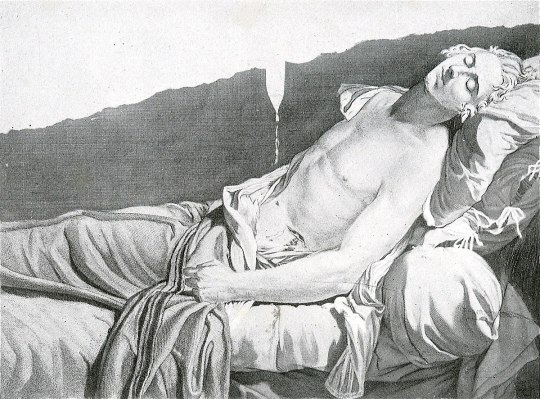
(This image is an engraving of the actual painting, which has gone missing)
After Marat on July 13 1793 (the very same day the plan for public education Lepeletier had been working on was presented to the Convention by Robespierre) became the second assassinated Convention deputy, we find several engravings etc, depicting the two ”martyrs of liberty” side by side.
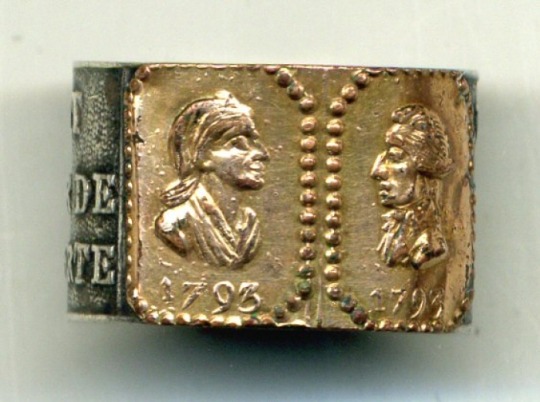



In the following months, even more people would be join the two, such as Joseph Chalier, a lyonnais politician executed on July 17 1793 and Joseph Bara, a fourteen year old republican drummer boy killed in the Vendée by the pro-Monarchist forces.

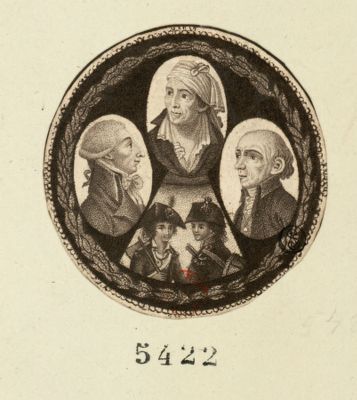
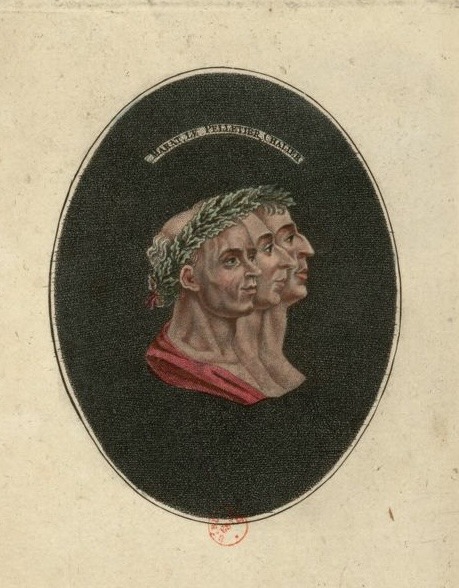

Lepeletier’s murderer, 27 year old Philippe Nicolas Marie de Pâris, a man who the minister of justice described as "former king's guard, height five pieds, five pouces, barbe bleue, and black hair; swarthy complexion, fine teeth, dressed in a gray cloak, green lapels and a round hat” on January 21, went into hiding right after his deed. In spite of his description being published in the papers and a considerable sum of money being promised to whoever caught him, Pâris managed to flee Paris and settled for a country house of an acquaintance near Bourget. He there ran into a cousin of one of the owners. When Pâris asked for food and a bed, he was refused and instead disappeared into the night again. In the evening of January 28 he arrived in Forges-les-Eaux and stopped at an inn, where he came under suspicion once he started cutting his bread with a dagger after which he locked himself into his room. The following morning he woke up with a start as five municipal gendarmes came bursting into his room and told him to come with them. Pâris responded that he would, but in the next second he had picked up his hidden pistol, placed it into his mouth, and pulled the trigger. Searching the dead body, the gendarmes found Pâris’ baptism record (dated November 12 1765) and dismissal from the king's guard (dated June 1 1792), on the latter of which had been written the following:
My certificate of honor. Do not trouble anyone. No one was my accomplice in the fortunate death of the scoundrel de Saint-Fargeau. Had I not run into him, I would have carried out a more beautiful action: I would have purged France of the patricide, regicide and parricide d’Orléans. The French are cowards to whom I say: Peuple dont les forfaits jettent partout l'effroi, Avec calme et plaisir j'abandonne la vie. Ce n'est que par la mort qu'on peut fuir l'infamie Qu'imprime sur nos fronts le sang de notre roi. Signed by Paris the older, guard of the king, assassinated by the French.
Learning about what had happened, the Convention tasked Tallien and Legrand with going to Forges-les-Eaux and making sure the dead man really was Pânis. Having come to the conclusion that this was indeed the case, the deputies briefly discussed whether the body ought to be brought back to Paris, but it was decided it would be better if it was just buried "with ignominy.” It was therefore instead taken into the nearby forest in a wheelbarrow and thrown into a six feet deep hole.
Finally, here are some other revolutionaries simping for honoring Lepeletier’s memory just because I can:
…a tragic event took place the day before the execution [of the king]. Pelletier, one of the most patriotic deputies, and who had voted for death, was assassinated. A king's guard made a wound three fingers wide with a saber: he died this morning. You must judge the effect that such a crime has had on the friends of liberty. Pelletier had an income of six hundred thousand livres; he had been président à mortier in the Parliament of Paris; he was barely thirty years old; to many talents, he added the most estimable of virtues. He died happy, he took to his grave the idea, consoling for a patriot, that his death would serve the public good. Here then is one of these beings whom the infamous cabal who, in the Convention, wanted to save Louis and bring back slavery, designated to the departments as a Maratist, a factious, a disorganizer... But the reign of these political rascals is finished. You will see the measures that the Assembly took both to avenge the national majesty and to pay homage to a generous martyr of liberty. Philippe Lebas in a letter to his father, January 21 1793
Ah! if it is true that man does not die entirely and that the noblest part of himself survives beyond the grave and is still interested in the things of life, come then, dear and sacred shadow, sometimes to hover above the Senate of the nation that you adorned with your virtues; come and contemplate your work, come and see your united brothers contributing to the happiness of the homeland, to the happiness of humanity. Marat in number 105 (January 23 1793) of Journal de la République Française
O Lepeletier! Your death will serve the Republic: I envy your death. You ask for the honors of the Pantheon for him, but he has already collected the prize of martyrdom of Liberty. The way to honor his memory is to swear that we will not leave each other without having given a constitution to the Republic. Danton at the Convention, January 21 1793
O Le Peletier, you were worthy to die for your homeland under the blows of its assassins! Dear and sacred shadow, receive our wishes and our oaths! Generous citizen, incorruptible friend of the truth, we swear by your virtues, we swear by your fatal and glorious death to defend against you the holy cause of which you were the apostle; we swear eternal war against the crime of which you were the eternal enemy, against the tyranny and treason of which you were the victim. We envy your death and we will know how to imitate your life. They will remain forever engraved in our hearts, these last words where you showed us your entire soul; ”May my death,” you said, “be useful to the homeland, may it will serve to make known the true and false friends of liberty, and I die content.” Robespierre at the Jacobins, January 23
Wednesday 23 [sic] — We went to Madame Boyer’s to see the procession. I saw the poor Saint-Fargeau. We all burst into tears when the body passed by, we threw a wreath on it. After the ceremony, we returned to my house. Ricord and Forestier had arrived. I was unable to stop my tears for some time. F(réron), La P(oype), Po, R(obert) and others came to dinner. The dinner was quite fun and cheerful. Afterwards they went to the Jacobins, Maman and I stayed by the fire and, our imaginations struck by what we had seen, we talked about it for a while. She wanted to leave, I felt that I could not be alone and bear the horrible thoughts that were going to besiege me. I ran to D(anton’s). He was moved to see me still pale and defeated. We drank tea, I supped there. Lucile Desmoulins in her diary, January 24 1793
…Pelletier's funeral took place this Thursday as I informed you in my last letter (this letter has gone missing). The procession was immense; it seemed that the population of Paris had doubled, to honor the memory of this virtuous citizen. The mourning of the soul was painted on all the faces: it was especially noticed that the people were extremely affected, which proves that they keenly felt the price of the friend they had lost. Arriving at the Pantheon, Lepelletier's body was placed on the platform prepared for it; his brother delivered a speech which was applauded with tears; Barère succeeded him. Then the members of the Convention, crowding around the body of their colleague, promised union among themselves, and took an oath to save the country. God grant that we have not sworn in vain, that we finally know the full extent of our duties, and that we only occupy ourselves with fulfilling them! In yesterday's session, Pelletier's daughter, aged eight [sic], was presented to the National Convention, which immediately adopted her as a child of the homeland. Georges Couthon in a letter written January 26 1793
How could I be so base as to abandon myself to criminal connections, I who, in the world, have never had more than one close friend since the age of six? (he gestures towards David's painting). Here he is! Michel Lepeletier, oh you from whom I have never parted, you whose virtue was my model, you who like me was the target of parliamentary hatred, happy martyr! I envy your glory. I, like you, will rush for my country in the face of liberticidal daggers; but did I have to be assassinated by the dagger of a republican! Hérault de Sechelles at the Convention, December 29 1793
For a collection of Lepeletier’s works, see Oeuvres de Michel Lepeletier Saint-Fargeau, député aux assemblées constituante et conventionnelle, assassiné le 20 janvier 1793, par Paris, garde du roi (1826)
#hérault and lepeletier being bffs since age six was new information for me#also i think Augustin just found a rival in ”most loyal little bro in the revolution”#frev#michel lepeletier#lepeletier de saint-fargeau#french revolution#ask#long post
65 notes
·
View notes
Text



Welcome to the 43rd installment of 15 Weeks of Phantom, where I post all 68 sections of Le Fantôme de l’Opéra, as they were first printed in Le Gaulois newspaper 115 yeas ago.
In today’s installment, we have Chapter 17, “Christine ! Christine !” (“Christine! Christine!”), as well as Part I of Chapter 18, “Révélations étonnantes de Mme Giry, relatives à ses relations personnelles avec le fantôme de l’Opéra” (“Mme Giry’s Astonishing Revelations, Regarding Her Personal Relations with the Phantom of the Opera”).
This section was first printed on Tuesday, 30 November, 1909.
For anyone following along in David Coward's translation of the First Edition of Phantom of the Opera (either in paperback, or Kindle, or from another vendor -- the ISBN-13 is: 978-0199694570), the text starts in Chapter 16 with, “Following Christine Daaé’s startlingly phantasmagoric disappearance, Raoul’s first thought had been to suspect Erik,” and goes to Chapter 17, “…in which Messrs Richard and Moncharmin had locked themselves for reasons still unclear to the reader which it is my duty as chronicler to keep hidden from him no longer.”
NOTE: The ending of this section in the Gaulois text differs from the ending in the First Edition, since in Chapter 17 of the First Edition, Leroux summarized the events that transpired in “The Magic Envelope” (the chapter that Leroux omitted from the First Edition, for which I published the first English translation). See #6 below.
There are some differences between the Gaulois text and the First Edition. In this section, these include (highlighted in red above):
1) Chapter XVIII was printed as Chapter XIX. This numbering error was made in Chapter VII, and was not corrected, so it was propagated throughout the Gaulois publication.
2) Chapter 18 in the Gaulois text is Chapter 17 in the First Edition, etc.
3) This passage appeared in the Gaulois text, but was omitted from the First Edition:
Que va-t-il devenir ? Que devient-elle ? Où est-elle ?…
Translation:
“What was to become of him? What was to become of her? Where was she?”
4) Compare the Gaulois text:
Oui, Christine lui a bien parlé de cela !… Et il court, il sort.
Translation:
“Yes, Christine had spoken to him of that!… And he rushed out.”
To the First Edition:
Oui, Christine lui a bien parlé de cela !… Et après avoir constaté, hélas ! que la lourde clef n'est pas dans le coffret, il n'en court pas moins à la rue Scribe.
Translation:
“Yes, Christine had spoken to him of that!… And after noting, alas, that the weighty key was not in its box, he nevertheless rushed to the Rue Scribe.”
5) This line was added to the First Edition, and did not appear in the Gaulois text:
Le Persan !
Translation:
“The Persian!”
6) In the First Edition, the following section of the Gaulois text was cut from "Mme Giry’s Astonishing Revelations," and a section was added to summarize "The Magic Envelope." In Coward’s translation, this added text goes from, “I have had occasion to observe that, over a period, the mood of both Directors had changed for the worse” and goes to, “The next time eventually came round… as it happened, on the very day of Christine Daaé’s disappearance.”
In the Gaulois text, Leroux wrote (highlighted in red above):
I will surprise no one in stating that MM. Richard and Moncharmin had not abandoned the hope of returning the first twenty thousand francs to their cashbox, which the Phantom had taken out. And to this purpose, they had not hesitated to risk twenty thousand more. This is, moreover, a bold wager, or if you will, a daring calculation, which is rather common amongst unlucky gamblers. The Managers had lost the first round against P. of the O. They hoped to win the second.
“May the second round go to us!” Richard had thus exclaimed… “I have only preached patience, my poor Moncharmin, so that we may better catch P. of the O. with his hand in the till.”
The till, in this case, was none other than the magic envelope.
7) Minor differences in punctuation.
Click here to see the entire edition of Le Gaulois from 30 November, 1909. This link brings you to page 4 of the newspaper — Le Fantôme is at the bottom of the page in the feuilleton section. Click on the arrow buttons at the bottom of the screen to turn the pages of the newspaper, and click on the Zoom button at the bottom left to magnify the text.
#phantom of the opera#poto#gaston leroux#le fantôme de l’opéra#le gaulois#phantom translation#15 weeks of phantom#phantom 115th anniversary
17 notes
·
View notes
Text
Featured Plate: 1891-04 MDM16-2694
Colour plate from Le Moniteur de la Mode for April of 1891, signed Jules David and E. Tailland.

Toilettes de Made. Moslard, 96 rue St Lazare. Soieries & Hautes nouveautés des Fabriques Lyonnaises. Lait Antéphélique pour le teint de Candès & Gie, 16 Boulevard St. Denis. Perfumerie Exotique Mon. Senet, 35 rue du Quatre-Septembre.
"Entered at Stationer's Hall" = likely appears in an english-language publication, not sure which one at this point in time. Will update if/when I figure that out.
1891-04 MDM16-2964
#fashion plate#historical fashion#french fashion plate#victorian fashion plate#1890s#1890s fashion#Moniteur de la Mode#Goubaud publication#description needed#Jules David
10 notes
·
View notes
Text
California Gov. Gavin Newsom signed a bill Monday aimed at advancing the restitution of Nazi-looted art, as well as personal property stolen during the Holocaust and other eras of political persecution.
The legislation is a response to a court ruling that allowed a work by Camille Pissarro to remain in a Spanish museum instead of returning to the heirs of its original owners. The 1897 painting, called “Rue Saint-Honoré in the Afternoon, Effect of Rain,” belonged to Fritz and Lilly Cassirer, a Jewish couple who sold it under duress to escape the Nazis.
The painting by Pissarro, a French Jewish impressionist, now hangs in the Museo Nacional Thyssen-Bornemisza in Madrid. The museum has claimed ownership of the work under a “finders keepers” law of property ownership that is unique to Spain.
In January, the Ninth Circuit Court of Appeals was instructed to decide the case according to California state law. But it ruled that, even according to California, Spain’s legal system took precedence. “Rue Saint-Honoré,” according to that decision, belonged to the museum.
The new California law, signed at Los Angeles’ Holocaust Museum, clarifies that California law should take precedence in local Holocaust art restitution cases. It allows Californians “to bring an action for damages or to recover artwork or personal property, as defined, that was stolen or otherwise lost as the result of political persecution.”
According to the law, “California substantive law shall apply in actions to recover fine art,” and that “the true owner cannot be divested of ownership without actual discovery of their rights in, and the location and possessor of, the artwork.”
The legislation could send the decades-long ownership dispute over the Pisarro painting back to the courts — and award the painting to the Cassirers’ descendants.
“As a Holocaust survivor, the proudest day of my father’s life was in 1947, when he became a U.S. citizen,” David Cassirer, grandson of Fritz and Lilly Cassirer, told the LA Times. “He would be so happy, and grateful, that the people of the state of California have taken action to ensure the return of looted art to its rightful owners.”
Spain is one of the original 44 international signatories of the Washington Principles, a 1998 framework for restituting artwork stolen during the Holocaust. In 2018, Stuart Eizenstadt, the Secretary of State’s special advisor on Holocaust issues, named Spain as one of five countries that fell short on its commitment to the Washington Principles.
Authorities in New York City and around the world have made renewed efforts in recent years to restitute art that was sold under duress due to Nazi persecution. Earlier this year, 21 countries agreed to new standards in art restitution at a conference marking the 25th anniversary of the Washington Principles.
“Restitution is important, not just to get people their property back, but because it is a way to examine the true realities of the Holocaust and keep those facts in the public consciousness,” Sam Dubbin, an attorney representing the Cassirer family, told the Jewish Telegraphic Agency. “It’s stolen property. It’s the Holocaust, which makes it 1,000 times worse, but it’s still fundamentally stolen property. And no one should be able to keep stolen property.”
The oil painting was bought directly from Camille Pissarro by German Jewish industrialist and art collector Julius Cassirer, who passed it down to his son Fritz and his wife Lilly. Lilly was forced to sell the painting under duress in 1939 for about $360 at the time in order to obtain an exit visa for England. The money was then deposited into a bank account that she was not permitted to access.
The painting made its way around the world over the next several decades, eventually landing in the collection of Baron Heinrich Thyssen-Bornemisza, a Swiss art collector and the heir to a German steel fortune. Thyssen-Bornemisza sold his collection to the Kingdom of Spain in 1993, which established a foundation and museum in Spain in his name.
The Museo Thyssen did not respond to a request for comment.
After he learned of the location of the Pissarro painting, the couple’s sole heir, Claude Cassirer, sued for its return in 2005. He died five years later, and now his son David, his daughter Ava’s estate and the Jewish Federation of San Diego County are handling the case.
“For survivors of the Holocaust and their families, the fight to take back ownership of art and other personal items stolen by the Nazis continues to traumatize those who have already gone through the unimaginable,” Newsom said Monday. “It is both a moral and legal imperative that these valuable and sentimental pieces be returned to their rightful owners, and I am proud to strengthen California’s laws to help secure justice for families.”
24 notes
·
View notes
Text

Who I write for :
Criminal Minds
- Emily Prentiss
- Aaron Hotchner
- Spencer Reid
- Jennifer Jareau
- Alex Blake
- Elle Greenaway
- Derek Morgan
- Penelope Garcia
- David Rossi
- Jason Gideon
- Kate Callahan
- Ashley Seaver
Marvel
- Natasha Romanoff
- Yelena Belova(Platonic only)
- Kate Bishop
- Wanda Maximoff
- Carol Danvers
- Tony Stark
Brooklyn 99
- Rosa Diaz
- Amy Santiago
- Gina Linetti
Percy Jackson
- Annabeth Chase
- Hazel Levesque
- Piper McLean (Female reader only)
- Nico Di Angelo (Male reader only)
- Percy Jackson
- Frank Zhang
- Leo Valdez
- Jason Grace
- Reyna Ramirez-Arellano (Platonic Only)
- Will Solace
- Thalia Grace (Platonic only)
- Clarisse La Rue
AGGGTM
- Pippa Fitz-Amobi
- Ravi Singh
- Cara Ward
- Naomi Ward
Wednesday
- Wednesday Addams x reader
- Enid Sinclair x reader
Please request something! Anything really :)
#emily prentiss x reader#aaron hotchner x reader#spencer reid x reader#jennifer jareau x reader#alex blake x reader#elle greenaway x reader#derek morgan x reader#penelope garcia x reader#david rossi x reader#jason gideon x reader#kate callahan x reader#ashley seaver x reader#natasha romanoff x reader#yelena belova x reader#kate bishop x reader#wanda maximoff x reader#carol danvers x reader#tony stark x reader#rosa diaz x reader#amy santiago x reader#gina linetti x reader#annabeth chase x reader#hazel levesque x reader#piper mclean x reader#nico di angelo x reader#agggtm x reader#percy jackson x reader#leo valdez x reader#frank zhang x reader#reyna Ramirez-Arellano x reader
37 notes
·
View notes
Text
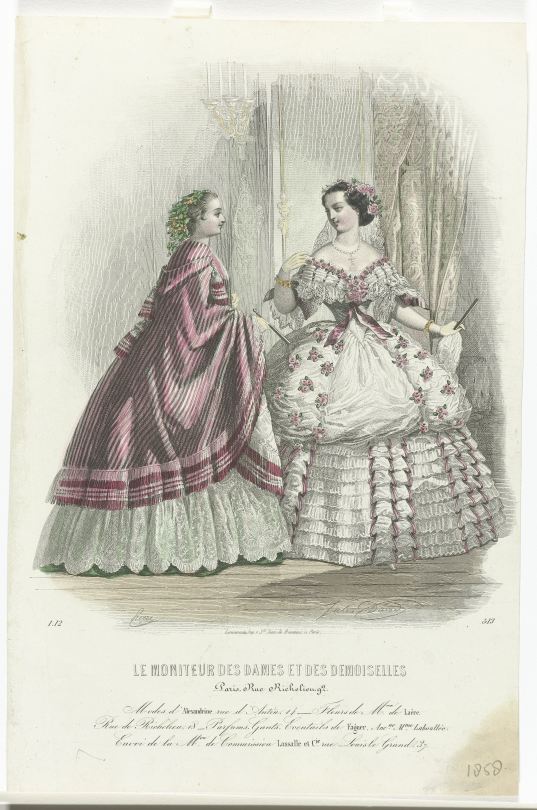
‘Le Moniteur des Dames et des Demoiselles’
Caption: ‘Modes d'Alexandrine rue d'Antin, 14_ Fleurs de M.me de Laëre. Rue de Richelieu, 18_ Parfums, Gants, Eventails de Faguer, Ane.ne M.me Laboullée. Envoi de la M.on de Commission Lassalle et C.ie rue Louis le Grand, 37.’
print maker: Sierre
after drawing by: Jules David (1808-1892)
printer: Lamoureux
Paris, 1858
(x)
#vintage fashion plates#french fashions#ilovethis#vintage fashion#victorian fashion#fashion history#rijksmuseum
51 notes
·
View notes
Photo

📷 David McLane (?) Blizzard surprise sur la 42e rue / Unexpected Blizzard on 42nd Street New York City 1967
8 notes
·
View notes
Text
Topino Lebrun, a revolutionary Jacobin close to Babeuf, executed under Bonaparte, is either forgotten or demonized

François Jean-Baptiste Topino-Lebrun, La Mort de Caius Gracchus (1798 Marseille, musée des Beaux-arts)
Topino Lebrun is an interesting revolutionary, though often overshadowed by other revolutionary artists like Jacques Louis David. According to the Annales Historiques de la Révolution Française, he was a lifelong patriot, whether as a student of Jacques Louis David or in Rome. Then, in 1793, he became a juror of the Revolutionary Tribunal, a position he maintained even after 9 Thermidor.
Although a democrat and a staunch Jacobin, close to the revolutionary Antonelle (who is featured in a post here: Antonelle), and a subscriber to the Tribun du Peuple, he may have transmitted a text written in prison that became issue 34 of Tribun du Peuple. While he sympathized with Babeuf, he was by no means a Babouvist, at least not involved in the Conspiracy, contrary to popular belief. However, he was part of the "Société du Manège," where former Jacobins gathered at the Manège Hall of the Tuileries (according to the website Les Amis de Gracchus Babeuf, this society had 3,000 members, including former Babouvists like Drouet, Félix Lepeletier, etc.). Claude Mazauric places Topino Lebrun in the Directorial Left, close to Marc-Antoine Jullien and Antonelle, but not within Babouvism.
Now, where there is uncertainty is in understanding Topino Lebrun's true intentions when painting La mort de Caius Gracchus translate in english The Death of Caius Gracchus (which he began in 1792). Was he aiming, by the time of its completion, to make the painting a tribute to Babeuf, who had recently been executed by guillotine? Claude Mazauric believes it is not a Babouvist propaganda painting but "a sort of specific contribution to the maintenance of the revolutionary myth in the national consciousness," though there is a tribute to the revolutionary tribune. According to the Amis de Gracchus Babeuf, Topino Lebrun intended for this painting to allude to Babeuf's death, making it a homage.
In 1800, following the royalist-led attack on Rue Saint-Nicaise, Bonaparte seized the opportunity to eliminate the Jacobins (as discussed here: The Jacobins Executed by Bonaparte). Topino Lebrun's artist friend, Giuseppe Ceracchi, was implicated in the so-called "Opera Dagger Plot" (a fabricated scheme) and was tortured. To stop the pain, the poor Ceracchi gave up Topino Lebrun's name (or perhaps he was forced to mention him, given Topino Lebrun's association with the republican and Jacobin opposition). Through torture, a role was fabricated for Topino Lebrun, who was falsely accused of supposedly supplying twelve daggers to conspirators. Thus, a dark legend arose about him as an assassin, or in the words of Claude Mazauric, "an unaltered blood-drinker." Bonaparte said of him and his comrades, "these craftsmen, reinforced by these painters (presumably referring to Ceracchi and Topino Lebrun, among others), have a fiery imagination, a bit more education than the people, they live among the people and exert influence over them."
Thus, five years after Babeuf, Topino Lebrun joined him on the scaffold.
Sources:
Claude Mazauric: Annales Historiques de la Révolution Française, report on the painter Topino Lebrun.
Exhibition by the Association Les Amis de Gracchus Babeuf.
#frev#french revolution#napoleonic era#babeuf#Lepeletier#Antonelle#Marc-Antoine Jullien#Topino Lebrun#jacques louis david#Giuseppe Ceracchi#napoleon bonaparte#history
7 notes
·
View notes
Photo

David E Scherman. Rue de la Huchette, Paris 1947.
83 notes
·
View notes
Text

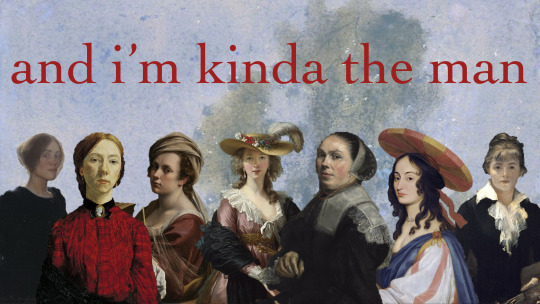
Self-Portrait - Raphael // Self-Portrait with a Green Vest – Eugène Delacroix // Self-Portrait – Diego Velázquez // Portrait of a Man (Self Portrait) – Jan van Eyck // Self-Portrait - Jean-Baptiste-Pierre Le Brun // Self-Portrait - Jacques-Louis David // Self-Portrait – Peter Paul Rubens // Mont Blanc and the Glacier des Bossons Looking Down the Arve��Valley – JMW Turner // Self-Portrait – Elin Danielson-Gambogi // Self-Portrait - Gwen John // Self-Portrait as Saint Catherine of Alexandria – Artemisia Gentileschi // Self-Portrait in a Straw Hat – Élisabeth Louise Vigée Le Brun // Self-Portrait – Judith Leyster // Self-Portrait – Louise Hollandine of the Palatinate // Self-Portrait with Palette – Marie Bashkirtseff // La Rue des Clos Moreaux – Gwen John
#elin danielson gambogi#gwen john#artemisia gentileschi#elisabeth louise vigee le brun#judith leyster#louise hollandine of the palatinate#marie bashkirtseff#you're just a boy (and i'm kinda the man)#yjabaiktm#maisie peters#maisie peters the good witch#the good witch maisie peters#the good witch#art#art history#lyrics#lyric art
70 notes
·
View notes
Text
Leo, luego existo, por David Uclés
Diez años. Sonrío al leer que quien mató a Goliath se llama David. Sobrevivo a las siestas en el olivar gracias a 13, Rue del Percebe. Once. Rompo la hucha y me gasto Origen: Leo, luego existo, por David Uclés

View On WordPress
2 notes
·
View notes
Text

masterlist 【!】
• Harry Potter
- harry potter - ron weasley - hermione granger - draco malfoy - pansy parkinson - blaise zabini - tom riddle - fred and george weasley - sirius black - remus lupin
• Euphoria
- rue bennett - cassie howard - jules vaughn - maddy perez - kat hernandez - fezco - nate jacobs - lexi howard - elliot - chris mckay - ashtray
• Life is Strange 1 2 True Colors & Before the Storm
- max caulfield - chloe price - nathan prescott - victoria chase - rachel amber - warren graham - kate marsh - frank bowers - sean diaz - alex chen - gabe chen - steph gingrich - ryan lucan
• The Umbrella Academy
- luther hargreeves - diego hargreeves - allison hargreeevs - klaus hargreeves - five hargreeves - ben hargeeves - viktor hargeeves - lila pitts
• The Sparrow Academy
- marcus hargreeves - ben hargreeves - fei hargreeves - alphonso hargreeves - sloane hargreeves - jayme hargreeves
• Supernatural
- dean winchester - sam winchester - castiel - crowley - jack kline - rowena macleod - lucifer - gabriel
• Stranger Things
mike wheeler - jane hopper - lucas sinclair - erica sinclair (platonic) - will byers - dustin henderson - max mayfield - billy hargrove - steve harrington - robin buckley - nancy wheeler - jonathan byers - eddie munson - joyce byers - jim hopper
• The Walking Dead
- daryl dixon - rick grimes - maggie greene - negan - michonne grimes - carl grimes - glenn rhee - rosita espinosa - king ezekiel - jesus - abraham ford - shane walsh
• Outer Banks
- jj maybank - john b routledge - sarah cameron - pope heyward - kiara carrera - rafe cameron
• 13 Reasons Why
- clay jensen - hannah baker - jessica davis - justin foley - tony padilla - zach dempsey - alex standall - tyler down - skye miller
•Slashers/horror
- stu macher - billy loomis - jennifer check - colin gray - ethan landry - [will be adding more i just dont know how to write for some other movies cause i dont know all the lore for them 😭]
•Jackass/Viva La Bam
- bam margera - johnny knoxville - ryan dunn - chris pontius - chris raab - brandon dicamillo
• Pitch Perfect 1 and 2 (i don't like 3 i apologize)
- beca - emily junk - chloe beale - stacie conrad - ashley - cynthia rose - jesse - bumper - benji - pieter kramer - kommissar
The Vampire Diaries/The Originals
-damon salvatore - stefan salvatore - elena gilbert - klaus mikealson - elijah mikealson - rebekah mikealson - kol mikealson - bonnie bennet - jeremey gilbert - caroline forbes - kai parker -
• Avengers (+Loki and Valkyrie)
- tony stark - steve rogers - peter parker - natasha romanoff- thor odinson - bruce banner - loki laufeyson - valkyrie
• Guardians of the Galaxy
-peter quill - gamora - nebula - rocket raccoon - drax - mantis
• ATSV/ITSV
- miguel o’hara - hobie brown - miles morales - peter b. parker - gwen stacy - pavitr prabhakar -
• Youtubers
- colby brock - sam golbach - jake webber - johnnie guilbert - tarayummy - anthony padilla - ian hecox - damien haas - shayne topp -
• Wednesday
- wednesday addams - enid sinclair - ajax petropolus - xavier thorpe - bianca barclay -
• Miscellaneous
- theodore finch - pete davidson - david wooderson - joel miller (show & game) - jake peralta - tate langdon - willy wonka (timothee chalamet) - felix catton - oliver quick - joe goldberg - spencer shay - freddie benson
[will probably update in the future!]
#the walking dead#outer banks#supernatural#stranger things#the umbrella academy#life is strange#euphoria#harry potter#scream#13 reasons why#jackass#pitch perfect#pitch perfect 2
20 notes
·
View notes